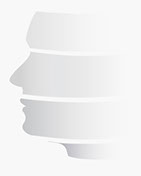Who has Migraines?
Migraine headache affects approximately 30-40 million Americans, although this figure may be higher as many patients do not know they have migraines or do not seek medical attention for their headaches. Often, if they do visit their doctor, it is commonly misdiagnosed as a stress headache or sinus infection. (An interesting fact is that migraine headaches are 100 times more common than sinus headaches.) The World Health Organization (WHO) estimates there are 400-500 million people worldwide that suffer from migraines and it is one of the top 10 most common causes of years lived with disability (YLDs) for women.
What is Migraine?
A migraine is a recurring headache which is often one-sided. They can be severe to the point of disability, but do not have to be to qualify as migraines. What makes migraines different than other headaches is they can cause other symptoms besides pain.
For example, migraines can make sufferers tired, light and sound sensitive, nauseous, dizzy, confused, have trouble speaking and lose sensation or vision. The most severe migraines will do some or all of these things at the same time, most commonly on a temporary basis, but if these symptoms last long enough they may become permanent or cause a stroke.
A majority of migraines (60%) are one-sided, and 15% always get the migraine on the same side. Children tend to experience the headache on both sides and often are nauseous even without a headache. The main symptoms experienced by migraineurs have been reported as follows:
85% of patients experience
pulsing or throbbing
70% experience neck pain
80% experience nausea
45% have sinus/cold-like symptoms
80% have sensitivity to light and noise
30% experience vomiting
Demographics
Before puberty, boys often experience migraines more than girls. However, after 12 years of age, migraine afflicts women three times more often than men and women are 50 times more likely to need medical help for treating their headaches. Migraineurs are most commonly between the ages of 15 and 55, although the peak prevalence age is 20 to 45 years old for both sexes. About a third of migraineurs get their first migraine before the age of 5. About 10 million children in the United States get migraines, and 70% to 80% of sufferers have a family history of migraine. Migraine is also strongly associated with household income and in the United States, migraine prevalence is highest in Caucasians, followed by African Americans and Asian Americans.
Migraine Types
Symptoms include gastric pain, bloating, nausea, vomiting and diarrhea. This type is more common in children.
Also called a "Silent Migraine". Migraineurs can suffer all the associated symptoms (see above) without the headache or with mild pain such as head and or neck heaviness.
The headache is both sides, usually located at the back of the head and may result in severe vomiting. This type is more common in teenagers or young adults and symptoms may include tinnitus (buzzing in the ear), vertigo (dizziness), numbness on both sides of the body, temporary blindness and loss of consciousness.
The migraine aura symptoms are prolonged (more than 30 minutes), lasting into or through the headache phase. Complicated migraine has many forms including ophthalmoplegic migraine, retinal migraine, hemiplegic (weakness on one side of the body) migraine and basilar migraine. All these forms have an increased risk of the migraine causing permanent neurological changes.
A rare and severe form of migraine characterized by one-sided weakness (stroke-like) which normally outlast the changes in sensation. Patients can experience numbness or paresthesias (abnormal sensation). The neurological symptoms usually lessen when the headache begins. This type tends to require hospitalization.
Menstrual migraines affect 70% of female migraine suffers. They most commonly occur before, but can happen during or immediately after the period and sometimes during ovulation (about 2 weeks later). Menstrual migraines are primarily caused when levels of estrogen decline right before the start of the menstrual period.
Migraine attacks that normally awaken the patient in the early morning. Migraine attacks may be triggered by alteration in sleep cycles, lack of sleep or oversleeping.
Migraineurs will only suffer the aura symptoms (visual changes) without the headache.
These are rare and patients develop partial or complete weakness of the muscles required for eye movement. The pain surrounds the eyeball and can last from a few days to months.
This is a continuous migraine which lasts longer than 72 hours potentially caused by the sterile inflammation response to the migraine. Migraineurs require treatment to reduce the risk of stroke, coma or death.
Migraine attacks become increasingly frequent and can be daily.
Abdominal
Acephalgic
Basilar
Complicated
Hemiplegic
Menstrual
Nocturnal
Ocular/Retinal
Opthalmoplegic
Status
Transformed/
Chronic
